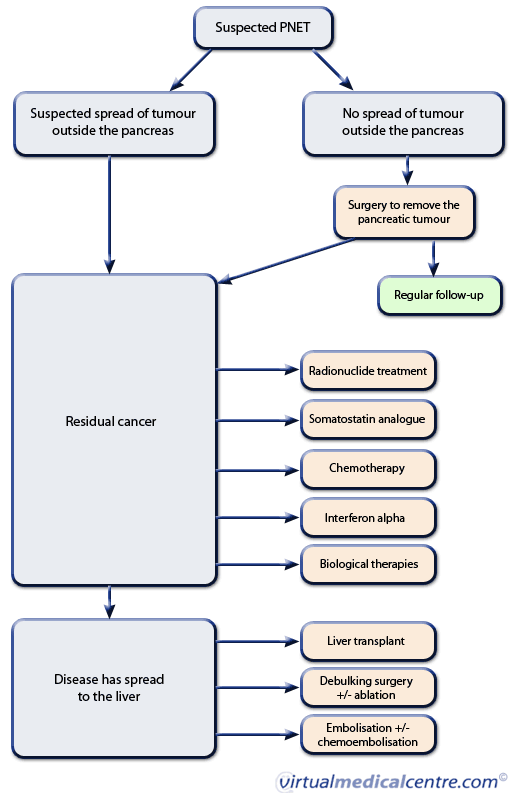- What is Pancreatic Neuroendocrine Tumour (PNET)?
- Statistics
- Risk Factors
- Progression
- Symptoms
- Clinical Examination
- How is it Diagnosed
- Prognosis
- Treatment
- References
What is Pancreatic Neuroendocrine Tumour (PNET)?
Pancreatic neuroendocrine tumours (PNETs) are a group of rare tumours that develop from specialised cells known as neuroendocrine cells within the pancreas. These cells are also located in the gastrointestinal tract, lungs and less commonly in the ovaries, testes, liver and bile ducts. The majority of tumours arising from these cells are located within the stomach, gut and pancreas.
The pancreas is a triangular-shaped gland that lies behind the stomachand is divided into a head, neck, body and tail.
 |
For more information, see Anatomy of the Gastrointestinal System. |
The pancreas is made up of two different types of cells, known as exocrine and endocrine cells. Exocrine cells secrete enzymes into the small intestine to aid digestion. Endocrine cells release hormones like insulin directly into the bloodstream. Several populations of hormone-producing cells are contained within the pancreas, and each cell type secretes a different hormone. For example, alpha cells produce glucagon, while beta cells produce insulin.
Two broad categories of PNETs are commonly described: functioning (secretes hormones) and non-functioning (doesn’t secrete hormones). Functioning tumours are further subtyped according to the hormone that they secrete. These include insulinomas, gastrinomas, VIPomas, glucagonomas, pancreatic polypeptide tumour, somatostatinoma and ACTHoma.
Statistics

One large study that looked at individuals with PNETs found that they occurred at a rate of 2.2 per 100,000 in the general population, with slightly more males (2.6 per 100,000) being affected than females (1.8 per 100,000). The average age at diagnosis was 58.5 years. Of the tumours diagnosed, 90.8% were non-functional, 2.5% malignant insulinomas, 6.7% malignant functional tumours other than insulinoma, 4.2% gastrinomas, 1.6% glucagonomas and 0.9% VIPomas.
PNET incidence increases with advancing age, with a peak incidence reported in the 6th and 7th decades of life.
The incidence of PNETs appears to be rising, a trend thought to be due to improved detection of these tumours.In a recent study of neuroendocrine tumours, incidence increased from 3 cases per 100,000 to 5.25 cases per 100,000 over a 1-year period.
Risk Factors
The majority of PNETs occur without a known cause. Approximately 10% of PNETs, however, occur as the result of an inherited syndrome. These syndromes are rare and include multiple endocrine neoplasia type 1 (MEN-1), von Hippel–Lindau (VHL) syndrome, neurofibromatosis or tuberous sclerosis.Individuals with these inherited conditions often have multiple tumours, which may be detected at a much younger age.
Progression
PNETs are rare tumours and as a result little is known about their nature and progression. These tumours are thought be slow growingand are more likely to be found incidentally on autopsy than they are to be identified from symptoms in a live individual.
The majority of PNETs are malignant when diagnosed, and approximately 60% of individuals with PNETs will have cancer that has spread to the liver when they first see their doctor. A large study found that 60.2% of PNETs had spread outside of the pancreas at the time of diagnosis, and in 20.7% of cases the primary (original) tumour had spread to tissues surrounding the pancreas.
One small study that looked at the progression of PNETs in individuals with the inherited condition of MEN-1 confirmed the slow growth of these tumours. MEN-1 is an inherited condition that can result in multiple PNETs in addition to other types of cancers. The average increase in tumour diameter was 1.3 mm per month and new tumours occurred at a rate of 0.62 new tumours per individual per year. As this study looked at progression in individuals with MEN-1 syndrome, it is difficult to know whether non-inherited forms of PNET progress at the same rate.
Symptoms

A study that looked at individuals with PNETs found the most common initial symptoms to be abdominal pain, followed by symptoms attributable to excess hormone production. In the remaining individuals, a lump, jaundice and diarrhoea were other less common symptoms.
Table 1 outlines the different symptoms associated with PNET subtypes.
Table 1: PNET subtypes and associated clinical symptoms
| PNET Subtype | Clinical Symptoms |
|---|---|
| Insulinoma |
|
| Gastrinoma |
|
| Pancreatic polypeptide tumour (PPoma) |
|
| VIPoma |
|
| Glucagonoma |
|
| Somatostatinoma |
|
| Non-functioning |
|
How is it Diagnosed
Your treating doctor will probably organise a range of different tests to help establish a diagnosis. These will include a combination of blood and hormone tests, biopsy of the tumour and a combination of imaging studies.
Blood tests
A range of different markers for PNETs can be detected in the blood. A protein called chromogranin A (CGA) is secreted by neuroendocrine tumours into the blood. The level of CGA in the blood corresponds to how big the tumour is, and this is therefore a useful marker. Other non-cancerous conditions can also cause higher CGA levels, including kidney disease, liver disease and medications called proton pump inhibitors. Pancreastatin, which is a fragment of CGA, can also be measured in the blood.
Serotonin, a chemical messenger, is also released by neuroendocrine tumours and is a useful marker that can be detected directly in the blood or via its by-product in the urine.
Hormone tests
Depending on symptoms present, specific hormone levels can be checked. Hormone levels are not always accurate as some functioning and even non-functioning tumours will test positive for several different hormones.
Biopsy
A biopsy of the tumour is imperative for establishing an accurate diagnosis. Your doctor will advise on the best method to obtain a biopsy. Once the biopsy is obtained, the tumour can be studied under a microscope by a trained specialist. Factors such as tumour subtype, tumour size, rate of growth of tumour cells, and extent of tumour spread can then be ascertained.
Imaging

It is common that a range of different imaging techniques be used to obtain the best information about the tumour. Current guidelines recommend using the combination of ultrasound, CT, MRI and SRS.The modalities used may vary depending on your tumour subtype and facilities available at your local radiology centre.
Ultrasound
Ultrasound is an imaging technique that uses ultrasound waves to visualise internal organs. In the setting of PNETs, US can be performed using three different methods. Transabdominal US involves a probe being placed over the abdomen to visualise the pancreas through the abdominal wall. Endoscopic ultrasound (EUS) involves a probe being passed via the mouth, down the gullet and into the stomach, from where the pancreas can be seen. The third technique involves using an ultrasound probe to better visualise the pancreas at the time of surgery, although this technique is rarely used these days.
The advantages of ultrasound are that it is cheap, simple and minimally invasive. Of the three methods described above, EUS is the most commonly used and is one of the best tools for picking up PNETs. If a tumour is detected using EUS, a biopsy of the pancreatic tumour can be obtained at the same time. EUS is able to detect 95% of PNETs, making it a very accurate tool. Tumours that are outside the pancreas or in the tail of the pancreas can, however, be difficult to see with this modality.
Computed tomography (CT)
CT is the most widely used imaging method for detecting and classifying PNETs.The introduction of multidetector row CT (MDCT) has significantly improved image resolution and tumour detection rates. The accuracy by which CT detects tumours depends on tumour size and location. Small tumours that are less than 1 cm in diameter are difficult to detect. Thirty per cent of tumours between 1 and 3 cm and 95% of tumours greater than 3 cm in size are detectable.
The advantages of CT are that disease outside of the pancreas can be detected at the same time, including spread to lymph nodes and other organs. The imaging technique is important and requires the individual to drink water beforehand so that the stomach is full. To minimise contraction of the stomach, which would obscure the image, a drug that temporarily halts digestion is injected via a tube into your vein.
Magnetic resonance imaging (MRI)
MRI is widely used to confirm CT findings or look for suspected tumours not found on CT and is considered superior to CT for assessment of PNETs involving abdominal organs. One study found that MRI was able to correctly identify 96% of PNETs. Different types of MRI imaging involving the administration of a contrast agent (a substance used to enhance the visibility of certain structures) are used to obtain more accurate images.
The advantages of MRI when compared to CT include the lack of radiation, safer contrast agents and the provision of more accurate information about the tumour.
Somatostatin receptor scintigraphy (SRS)
SRS is a useful tool for detecting PNETs, cancerous spread and monitoring response to treatment. This technique relies on the fact that most of the cancerous cells that make up PNETs have a somatostatin receptor on their surface. SRS involves injecting a substance with a special marker attached to it into the bloodstream. The substance then binds to these receptors, highlighting where the cancerous cells are located.
One limitation of this technique is that only 80–90% of PNETs have somatostatin receptors on their cell surface. Furthermore, cells in other tissues, including the thyroid, breast and spleen, can take up the radiolabelled compound, which gives a false result. Despite these limitations, SRS is considered to be one of the best tests available for detecting PNETs and associated spread of cancer cells.
Positron emission tomography (PET)
PET is an imaging method that assesses the glucose uptake of cancerous cells. It relies on the fact that cancerous cells use up much higher levels of glucose than normal cells as they are more metabolically active. To date, PET has not been a very accurate tool in the detection of PNETs, but the development of new techniques that allow the addition of contrast and tracer agents are currently being developed.
Angiography
Angiography is an imaging tool that allows the inside of blood vessels to be seen. In the case of PNETs, this technique is used to map the blood supply to the pancreas and areas of cancerous spread. Furthermore, blood from the veins draining the pancreas or liver can be analysed to detect hormone levels associated with PNET subtypes. This technique has been outdated by new CT methods and EUS.
Staging
To determine how advanced a tumour is a staging process is normally involved. The European Neuroendocrine Tumour Society developed a staging system for PNETs based on the commonly used Tumour Node Metastasis (TNM) system. The table below outlines the TNM staging system for PNETs. The stage of your cancer will be used to give information about treatment options and prognosis.
Table 2: TNM staging system for PNETs
| TNM Staging | Pancreas |
|---|---|
|
Tx |
Primary tumour cannot be assessed |
|
T0 |
No evidence of primary tumour |
|
T1 |
Tumour limited to pancreas and size < 2 cm |
|
T2 |
Tumour limited to pancreas and size 2–4 cm |
|
T3 |
Tumour limited to pancreas and size > 4 cm or invading duodenum or bile duct |
|
T4 |
Tumour invading adjacent organs (stomach, spleen, colon, adrenal gland) or the wall of large blood vessels (celiac or superior mesenteric artery) |
|
Nx |
Regional lymph nodes cannot be assessed |
|
N0 |
No regional lymph node metastasis |
|
N1 |
Regional lymph node metastasis |
|
Mx |
Distant metastasis cannot be assessed |
|
M0 |
No distant metastasis |
|
M1 |
Distant metastasis |
Prognosis

Recent improvements in detecting PNETs and increased rates of surgical removal of these tumours have been associated with significant improvements in survival rate. A number of recent studies have reported that 80% of individuals managed with a combination of surgical removal and drug therapy were alive 5 years after treatment. Where disease has spread to the liver and is not amenable to surgical removal, there is a lower 5-year survival rate of 29%.
Factors associated with poor outcome include advanced tumour stage (as per the TNM staging system), aggressive tumour growth and patient age. Patients with functioning tumours have better outcomes than those with non-functioning tumours.
The advent of new agents that interfere with the growth of tumour cells and thereby halt disease progression in individuals with metastatic disease is a promising sign for individuals with advanced PNETs.
Treatment
PNETs are best managed by a team of specialists in a facility that specialises in neuroendocrine tumours. The aim of treatment is to prolong survival and manage symptoms in order to improve quality of life. For those tumours that are able to be removed surgically, this is the only form of treatment that can completely cure the cancer. The remainder of PNETs may still benefit from surgery to reduce the tumour size in addition to non-surgical treatment strategies. These include somatostatin analogues, chemotherapy, interferon alpha, embolisation/chemoembolisation, peptide receptor targeted radiotherapy and selective internal radiation therapy. The recent development of drugs that halt tumour growth, known as biological therapies, has been a major breakthrough in the treatment approach to advanced PNETs. Your treating team will decide on the best management strategy, based on your type of tumour.
Management overview
Figure 1: Management algorithm for PNETs
Surgical treatment
Surgical removal of the tumour is the only form of curative treatment for PNETs. The aim of surgery is to remove as much cancerous tissue from the pancreas, lymph nodes and surrounding tissues as possible. A series of different blood and imaging tests are usually performed before the operation to determine the tumour size, location and function. Individuals who do undergo surgery will generally be treated with a drug to prevent life-threatening excess hormone production from the tumour during surgery.
Surgery to cure
Surgery to remove cancerous tissue may take the form of removing the tumour alone, removing parts or the whole pancreas, or a more extensive procedure known as a Whipple’s procedure. A Whipple’s procedure involves removing the gallbladder, part of the small intestine, the bile duct and the head of the pancreas.
The technique used will depend on how many tumours are present, where the tumours are located and how big they are. Improvements in surgical techniques have seen death rates associated with these surgical procedures drop from approximately 25% in the 1960s to less than 3% in recent times. Studies examining the effectiveness of surgery in this setting quote poor health due to disease ranging from 9% to 58%, and death rates ranging from 0 to 10%. Where the main tumour can be completely resected surgically, the long-term outcome is excellent.
Non-curative surgery
In those patients where curative removal of the tumour is not possible, the aims of surgery are to slow the growth of the tumour and treat symptoms associated with excess hormone production. This involves removing as much cancerous tissue as possible, and is associated with improved symptoms and prolonged survival.
Debulking surgery
Where complete tumour removal is not a viable option, a technique known as “cytoreductive” or “debulking” surgery is used. This involves removing as much of the cancerous tissue as possible to reduce the amount of hormones produced by the tumour and problems that arise from tumour size. Studies in which 90% of the cancerous tissue was removed surgically found that control of symptoms was achieved in 90% of individuals.
Liver transplantation
Liver transplantation is another option for individuals with a tumour that has spread to the liver. It can be combined with surgical removal of the main tumour in the pancreas, but is often performed as a separate operation.
Two small studies looking at prognosis in individuals with PNETs who underwent liver transplantation. The first found that 57% of individuals were alive 3 years after their transplant; and the second found that 90% of individuals were alive 5 years after their transplant, with symptom control reported to be as high as 100%.
Due to a limited number of organ donors, liver transplantation should be reserved for individuals where disease spread is limited to the liver and where other treatment strategies have failed.
Non-surgical treatment
Somatostatin analogues

Chemotherapy
Chemotherapy is another treatment option in patients with PNETs and can be used in addition to surgery or by itself to slow disease progression. It is generally reserved for patients who have disease that is not amenable to surgery or somatostatin analogues.Chemotherapy is occasionally used to shrink tumour size prior to surgical excision.
The most commonly used chemotherapy agents are streptozocin combined with either doxorubicin or 5-fluorouracil. Recent studies looking at a tablet form of chemotherapy known as temozolomide have shown promising results.
Interferon alpha
Interferon alpha is a natural protein released by cells of the immune system in response to a foreign antigen. It has the ability to stop the growth of cancer cells and increase the rate of cancer cell death. In the setting of PNETs, it can be used alone or in combination with somatostatin analogues. The combination regimen is thought to have an additive effect, resulting in more pronounced clinical improvement, inhibition of tumour growth and improved survival rates.Studies examining the effectiveness of this agent found that 40–75% of individuals had improvement in their symptoms and 15% had a reduction in size of their tumour. This drug is administered via injection under the skin three times a week. The main side effects are flu-like symptoms and lethargy.
Peptide receptor targeted radiotherapy
Peptide receptor targeted radiotherapy is a promising new tool in the treatment of patients with advanced cancerous spread. This technique involves delivering toxic radiotherapy to tumour cells by binding a radioactive molecule to the somatostatin analogues. As described above, these analogues bind directly to the somatostatin receptor on the surface of the tumour cells, allowing for directed radiotherapy. Individuals who are most likely to respond to this form of treatment are those with positive uptake on SRS scans. Early studies show promising results, but more research is required to compare this technique to other non-surgical interventions.
Embolisation/chemoembolisation
Embolisation and chemoembolisation are treatment options directed at the blood supply of cancerous lesions in the liver. Embolisation involves injecting a clotting substance to block the blood supply, and chemoembolisation adds direct injection of chemotherapy to this technique. Studies have found that 60–100% of individuals gained symptomatic relief with this technique. However, this technique cannot be used in individuals with clots affecting the blood supply of the liver or in those who have undergone Whipple’s procedure.
Selective internal radiation therapy
This technique allows toxic radiation to be delivered directly to cancerous cells through small radioactive beads that are injected into the main artery supplying blood to the liver. This allows for high doses of radiation to be delivered directly and continuously to the cancerous lesion. The majority of studies to date have examined this technique in the setting of bowel cancer, though a small collection of studies in individuals with neuroendocrine tumours have reported excellent results.
Biologically targeted therapies
Biologically targeted therapies use agents that interfere with the pathways involved in the growth and division of cancer cells. The two main targets are vascular endothelial growth factor (VEGF) and the mammalian target of rapamycin (mTOR) pathways.
mTOR inhibitors
mTOR is an enzyme that regulates tumour cell growth, proliferation and cell death. This enzyme also has a role in a number of other pathways involved in the growth of cancerous cells.
A new oral agent, everolimus, was approved by the US Food and Drug Authority (FDA) in 2011 following a large study of 410 patients with PNETs, conducted across different facilities. The RADIANT-3 trial showed that individuals with advanced PNETs who took a once daily dose of everolimus had a prolonged period in which their disease did not progress, when compared to individuals taking a placebo drug. 34% of the individuals receiving everolimus were alive at 18 months after everolimus treatment, compared to 9% of the placebo group.The most common side effects associated with everolimus were stomatitis, rash, diarrhoea and fatigue.
VEGF inhibitors
VEGF promotes the growth of new blood vessels in tumours, thus accelerating their rate of growth. Malignant PNETs have a lot of VEGF receptors. Agents known as tyrosine kinase inhibitors block the binding of VEGF to its receptors, thus inhibiting the formation of new blood vessels and thereby suppressing tumour growth. Tyrosine kinase inhibitors, namely pazopanib, sorafenib and sunitinib, have all been evaluated in individuals with advanced PNETs.
The most promising results were demonstrated in a large study of 171 individuals with advanced PNETs, using the tyrosine kinase inhibitor sunitinib. The average time period over which there was no progression in tumour growth was 11.4 months in the sunitinib group versus 5.5 months in the placebo group. The most frequent side effects associated with sunitinib were diarrhoea, nausea, vomiting, lack of energy and fatigue.
References
- Burgess A. An overview of pancreatic neuroendocrine tumours. Nurs Stand. 2008;23(8):35-40. [Abstract]
- Yao JC, Eisner MP, Leary C, et al. Population-based study of islet cell carcinoma. Ann Surg Oncol. 2007;14(12):3492-500. [Abstract | Full text]
- Ong SL, Garcea G, Pollard CA, et al. A fuller understanding of pancreatic neuroendocrine tumours combined with aggressive management improves outcome. Pancreatology. 2009;9(5):583-600. [Abstract]
- Marieb E. Human Anatomy and Physiology (3rd edition). California: Benjamin/Cummings Publishing Co; 1991. [Book]
- Moore KL, Dalley AF, Agur AM (eds). Clinically Oriented Anatomy (6th edition). Philadelphia, PA: Lippincott Williams & Wilkins; 2009. [Book]
- Tan EH, Tan CH. Imaging of gastroenteropancreatic neuroendocrine tumors. World J Clin Oncol. 2011 Jan 10;2(1):28-43. [Abstract | Full text]
- Wang DS, Zhang DS, Qiu MZ, et al. Prognostic factors and survival in patients with neuroendocrine tumors of the pancreas. Tumour Biol. 2011;32(4):697-705. [Abstract]
- Halfdanarson TR, Rabe KG, Rubin J, Petersen GM. Pancreatic neuroendocrine tumors (PNETs): Incidence, prognosis and recent trend toward improved survival. Ann Oncol. 2008;19(10):1727-33. [Abstract | Full text]
- Klöppel G. Tumour biology and histopathology of neuroendocrine tumours. Best Pract Res Clin Endocrinol Metab. 2007;21(1):15-31. [Abstract]
- Kulke MH, Bendell J, Kvols L, et al. Evolving diagnostic and treatment strategies for pancreatic neuroendocrine tumors. J Hematol Oncol. 2011;4:29. [Abstract | Full text]
- Oberg K, Akerström G, Rindi G, Jelic S. Neuroendocrine gastroenteropancreatic tumours: ESMO Clinical Practice Guidelines for diagnosis, treatment and follow-up. Ann Oncol. 2010;21(Suppl 5):v223-7. [Abstract | Full text]
- Lewis RB, Lattin GE Jr, Paal E. Pancreatic endocrine tumors: Radiologic-clinicopathologic correlation. Radiographics. 2010;30(6):1445-64. [Abstract]
- Alexakis N, Neoptolemos JP. Pancreatic neuroendocrine tumours. Best Pract Res Clin Gastroenterol. 2008;22(1):183-205. [Abstract]
- Mayo SC, de Jong MC, Bloomston M, et al. Surgery versus intra-arterial therapy for neuroendocrine liver metastasis: A multicentre international analysis. Ann Surg Oncol. 2011. [Abstract]
- Kann PH, Balakina E, Ivan D, et al. Natural course of small, asymptomatic neuroendocrine pancreatic tumours in multiple endocrine neoplasia type 1: An endoscopic ultrasound imaging study. Endocr Relat Cancer. 2006;13(4):1195-202. [Abstract | Full text]
- Nissen NN, Kim AS, Yu R, et al. Pancreatic neuroendocrine tumors: Presentation, management, and outcomes. Am Surg. 2009;75(10):1025-9. [Abstract]
- Joseph S, Wang YZ, Boudreaux JP, et al. Neuroendocrine tumors: Current recommendations for diagnosis and surgical management. Endocrinol Metab Clin North Am. 2011;40(1):205-31. [Abstract]
- Rockall AG, Reznek RH. Imaging of neuroendocrine tumours (CT/MR/US). Best Pract Res Clin Endocrinol Metab. 2007;21(1):43-68. [Abstract]
- Mason K, Higgs SM, Norton SA. Endoscopic ultrasound in the assessment of solid and cystic pancreatic lesions. Br J Hosp Med (Lond). 2011;72(2):78-85. [Abstract]
- Oberstein PE, Saif MW. Novel agents in the treatment of unresectable neuroendocrine tumors. Highlights from the 2011 ASCO Annual Meeting. Chicago, IL, USA; June 3-7, 2011. JOP. 2011;12(4):358-61. [Abstract | Full text]
- Yao JC, Shah MH, Ito T, et al. Everolimus for advanced pancreatic neuroendocrine tumors. N Engl J Med. 2011;364(6):514-23. [Abstract | Full text]
- Peres J. Recent studies show promise for treating rare pancreatic tumors. J Natl Cancer Inst. 2011;103(8):624-7. [Abstract]
- Bilimoria KY, Tomlinson JS, Merkow RP, et al. Clinicopathologic features and treatment trends of pancreatic neuroendocrine tumors: Analysis of 9,821 patients. J Gastrointest Surg. 2007;11(11):1460-7. [Abstract]
- Raymond E, Dahan L, Raoul JL, et al. Sunitinib malate for the treatment of pancreatic neuroendocrine tumors. N Engl J Med. 2011;364(6):501-13. [Abstract | Full text]
- Braunwald E, Fauci AS, Kasper DL, et al. Harrison’s Principles of Internal Medicine (17th edition). New York, NY: McGraw-Hill Publishing; 2008. [Book]
- Jensen RT, Berna MJ, Bingham DB, Norton JA. Inherited pancreatic endocrine tumor syndromes: Advances in molecular pathogenesis, diagnosis, management, and controversies. Cancer. 2008;113(7 Suppl):1807-43. [Abstract | Full text]
- Gurusamy KS, Pamecha V, Sharma D, Davidson BR. Palliative cytoreductive surgery versus other palliative treatments in patients with unresectable liver metastases from gastro-entero-pancreatic neuroendocrine tumours. Cochrane Database Syst Rev. 2009;(1):CD007118. [Abstract | Full text]
All content and media on the HealthEngine Blog is created and published online for informational purposes only. It is not intended to be a substitute for professional medical advice and should not be relied on as health or personal advice. Always seek the guidance of your doctor or other qualified health professional with any questions you may have regarding your health or a medical condition. Never disregard the advice of a medical professional, or delay in seeking it because of something you have read on this Website. If you think you may have a medical emergency, call your doctor, go to the nearest hospital emergency department, or call the emergency services immediately.








